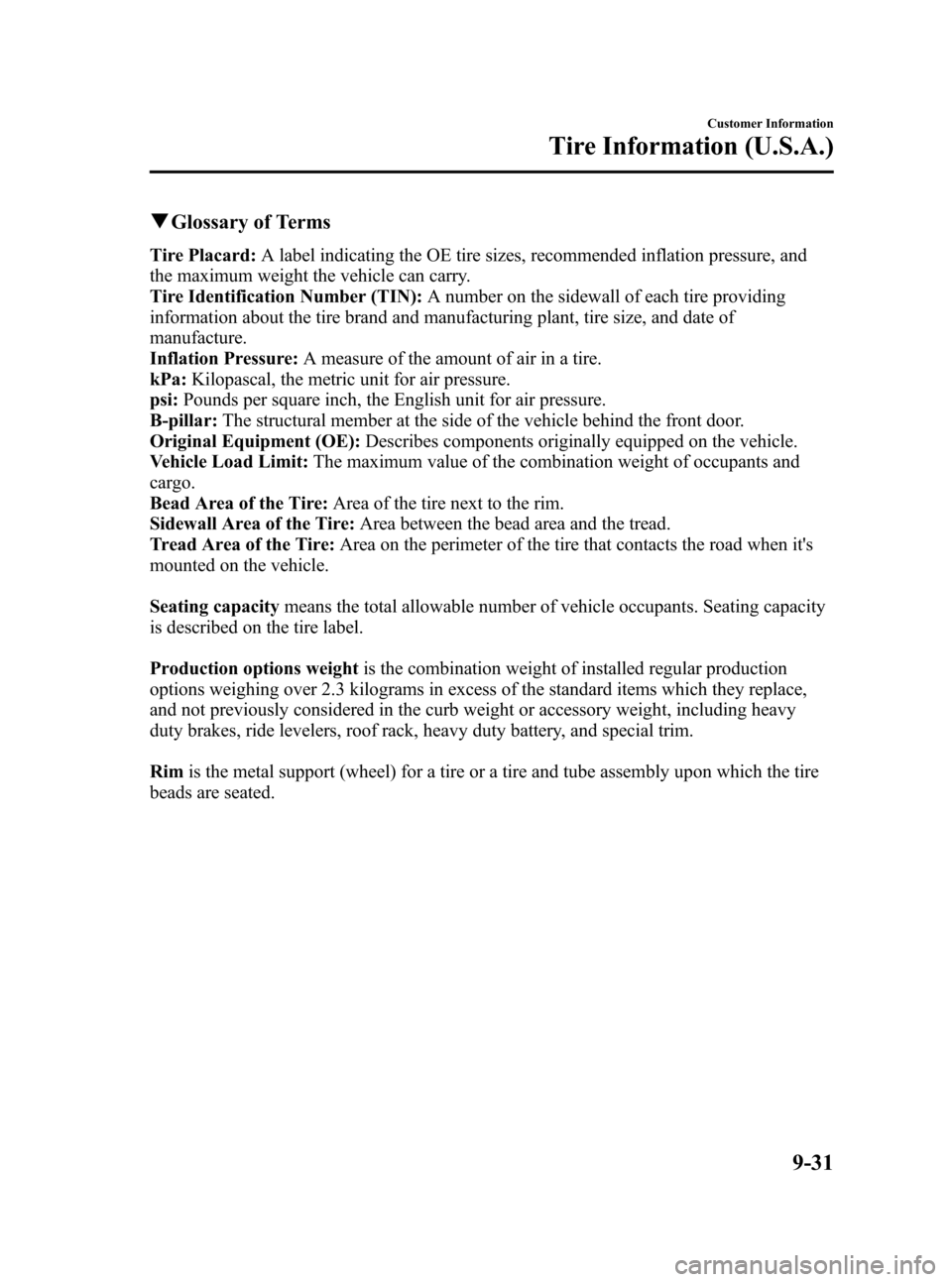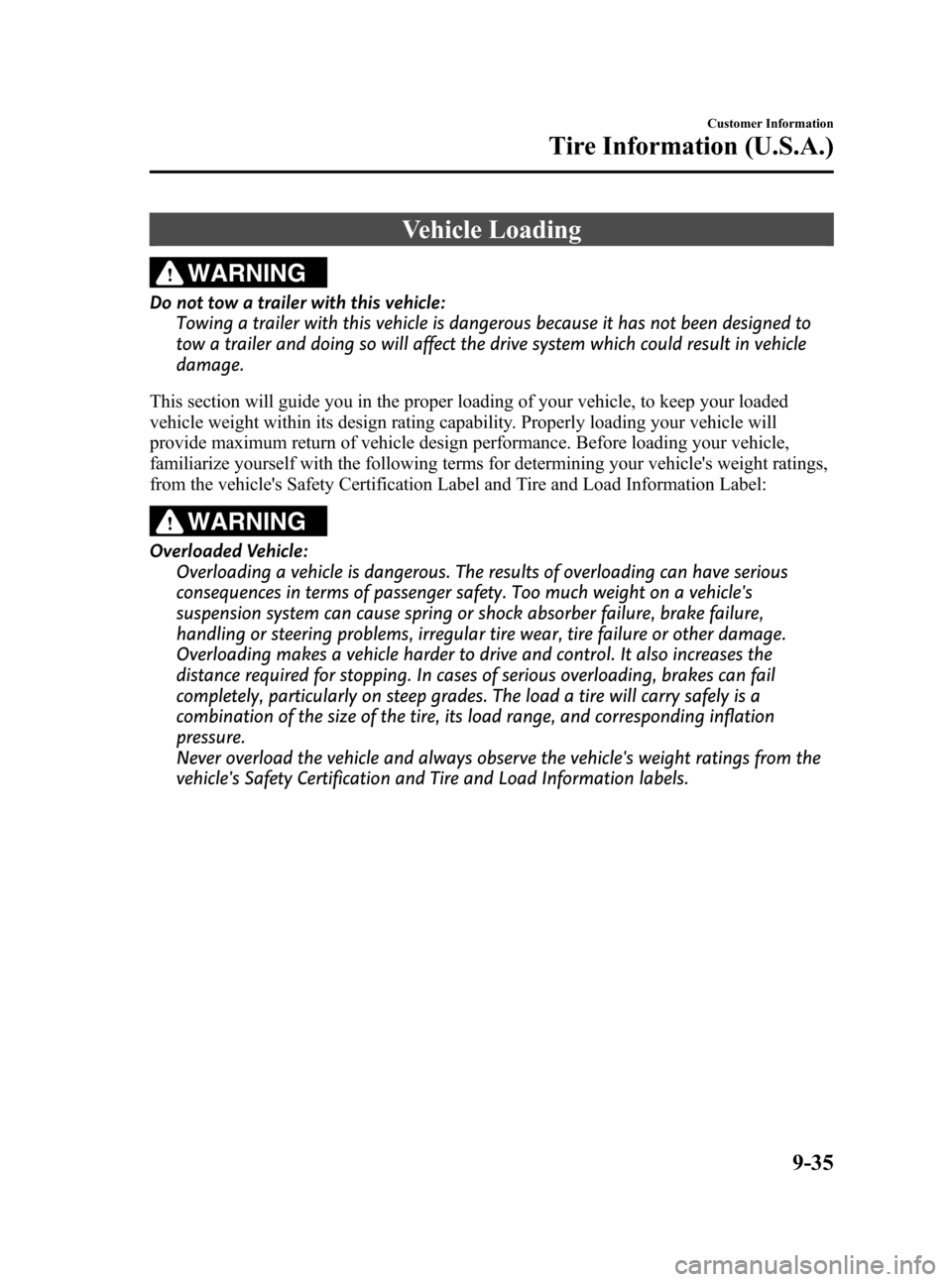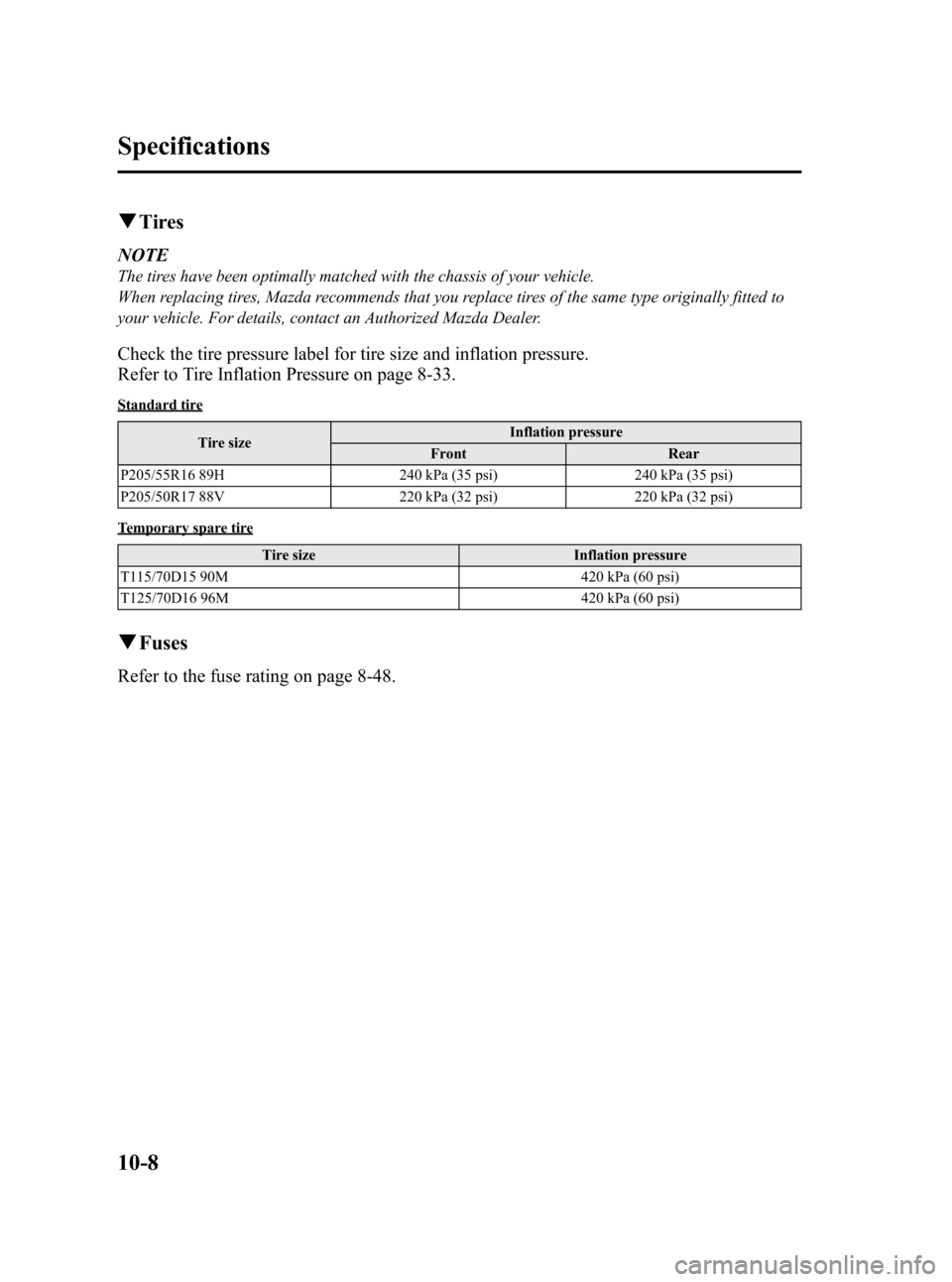tire size MAZDA MODEL 3 HATCHBACK 2010 (in English) User Guide
[x] Cancel search | Manufacturer: MAZDA, Model Year: 2010, Model line: MODEL 3 HATCHBACK, Model: MAZDA MODEL 3 HATCHBACK 2010Pages: 488, PDF Size: 6.52 MB
Page 453 of 488

Black plate (455,1)
qGlossary of Terms
Tire Placard:A label indicating the OE tire sizes, recommended inflation pressure, and
the maximum weight the vehicle can carry.
Tire Identification Number (TIN):A number on the sidewall of each tire providing
information about the tire brand and manufacturing plant, tire size, and date of
manufacture.
Inflation Pressure:A measure of the amount of air in a tire.
kPa:Kilopascal, the metric unit for air pressure.
psi:Pounds per square inch, the English unit for air pressure.
B-pillar:The structural member at the side of the vehicle behind the front door.
Original Equipment (OE):Describes components originally equipped on the vehicle.
Vehicle Load Limit:The maximum value of the combination weight of occupants and
cargo.
Bead Area of the Tire:Area of the tire next to the rim.
Sidewall Area of the Tire:Area between the bead area and the tread.
Tread Area of the Tire:Area on the perimeter of the tire that contacts the road when it's
mounted on the vehicle.
Seating capacitymeans the total allowable number of vehicle occupants. Seating capacity
is described on the tire label.
Production options weightis the combination weight of installed regular production
options weighing over 2.3 kilograms in excess of the standard items which they replace,
and not previously considered in the curb weight or accessory weight, including heavy
duty brakes, ride levelers, roof rack, heavy duty battery, and special trim.
Rimis the metal support (wheel) for a tire or a tire and tube assembly upon which the tire
beads are seated.
Customer Information
Tire Information (U.S.A.)
9-31
Mazda3_8AD6-EC-09A_Edition1 Page455
Tuesday, December 2 2008 2:28 PM
Form No.8AD6-EC-09A
Page 455 of 488

Black plate (457,1)
CAUTION
Rotate unidirectional tires and radial tires that have an asymmetrical tread pattern
or studs only from front to rear, not from side to side. Tire performance will be
weakened if rotated from side to side.
(With limited-slip differential)
Don't use the following:
ØTires not of the designated size
ØTires of different sizes or types at the same time
ØTires not sufficiently inflated
If these instructions aren't followed, the rotation of the left and right wheels will be
different and will thus apply a constant load on the limited-slip differential.
This will cause a malfunction.
qReplacing a Tire
WARNING
Always use tires that are in good condition:
Driving with worn tires is dangerous. Reduced braking, steering, and traction could
result in an accident.
If a tire wears evenly, a wear indicator will appear as a solid band across the tread. Replace
the tire when this happens.
New treadTread wear indicator
Worn tread
You should replace it before the band is across the entire tread.
NOTE
Tires degrade over time, even when they are not being used on the road. It is recommended that tires
generally be replaced when they are 6 years or older. Heat caused by hot climates or frequent high
loading conditions can accelerate the aging process. You should replace the spare tire when you
replace the other road tires due to the aging of the spare tire. Regarding the manufacturing week and
year is indicated with 4 digit. Refer to The tire labeling on page 9-23.
Customer Information
Tire Information (U.S.A.)
9-33
Mazda3_8AD6-EC-09A_Edition1 Page457
Tuesday, December 2 2008 2:29 PM
Form No.8AD6-EC-09A
Page 457 of 488

Black plate (459,1)
Vehicle Loading
WARNING
Do not tow a trailer with this vehicle:
Towing a trailer with this vehicle is dangerous because it has not been designed to
tow a trailer and doing so will affect the drive system which could result in vehicle
damage.
This section will guide you in the proper loading of your vehicle, to keep your loaded
vehicle weight within its design rating capability. Properly loading your vehicle will
provide maximum return of vehicle design performance. Before loading your vehicle,
familiarize yourself with the following terms for determining your vehicle's weight ratings,
from the vehicle's Safety Certification Label and Tire and Load Information Label:
WARNING
Overloaded Vehicle:
Overloading a vehicle is dangerous. The results of overloading can have serious
consequences in terms of passenger safety. Too much weight on a vehicle's
suspension system can cause spring or shock absorber failure, brake failure,
handling or steering problems, irregular tire wear, tire failure or other damage.
Overloading makes a vehicle harder to drive and control. It also increases the
distance required for stopping. In cases of serious overloading, brakes can fail
completely, particularly on steep grades. The load a tire will carry safely is a
combination of the size of the tire, its load range, and corresponding inflation
pressure.
Never overload the vehicle and always observe the vehicle's weight ratings from the
vehicle's Safety Certification and Tire and Load Information labels.
Customer Information
Tire Information (U.S.A.)
9-35
Mazda3_8AD6-EC-09A_Edition1 Page459
Tuesday, December 2 2008 2:29 PM
Form No.8AD6-EC-09A
Page 476 of 488

Black plate (478,1)
qTires
NOTE
The tires have been optimally matched with the chassis of your vehicle.
When replacing tires, Mazda recommends that you replace tires of the same type originally fitted to
your vehicle. For details, contact an Authorized Mazda Dealer.
Check the tire pressure label for tire size and inflation pressure.
Refer to Tire Inflation Pressure on page 8-33.
Standard tire
Tire sizeInflation pressure
Front Rear
P205/55R16 89H 240 kPa (35 psi) 240 kPa (35 psi)
P205/50R17 88V 220 kPa (32 psi) 220 kPa (32 psi)
Temporary spare tire
Tire size Inflation pressure
T115/70D15 90M 420 kPa (60 psi)
T125/70D16 96M 420 kPa (60 psi)
qFuses
Refer to the fuse rating on page 8-48.
10-8
Specifications
Mazda3_8AD6-EC-09A_Edition1 Page478
Tuesday, December 2 2008 2:29 PM
Form No.8AD6-EC-09A